Weather Almanac for February 2001
PERMAFROST: SPECTER OF THE GREAT ICE AGES

As February moves us into solar Spring and the groundhog has his day in the sun -- or shadow, many of us in the temperate areas of North America are looking forward to the end of this winter's cold grip and the unfreezing of streets, lawns and gardens.
But for residents in northernmost America and Eurasia, even during the height of summer, the ground beneath their feet remains solidly frozen. The frigid specter of winters past, the offspring of the last Great Ice Age, lurks underground awaiting the return of the ice. These are the lands of the permafrost.
 During the last two million years, great ice sheets covered much of the Northern Hemisphere, preventing the surface below them from rising above freezing temperatures. Over hundreds of millennia, the cold seeped ever deeper and deeper into the earth until its frigid advance was finally halted by the outward flow of heat from the Earth's hot interior. In this manner, great, thick layers of permanently frozen ground known as permafrost formed.
In the coldest northern areas of the continents, inland from the Arctic Ocean and at elevation, the ground never thaws. But further south, where the sun's rays provide enough heat to raise the surface temperature a few degrees above the melting point of ice, the top layer of frozen soil may thaw to a depth from a few inches to few feet. With nowhere to flow, the liquid water above the frozen subsoil forms shallow pools of standing water that soon will teem with life. During the last two million years, great ice sheets covered much of the Northern Hemisphere, preventing the surface below them from rising above freezing temperatures. Over hundreds of millennia, the cold seeped ever deeper and deeper into the earth until its frigid advance was finally halted by the outward flow of heat from the Earth's hot interior. In this manner, great, thick layers of permanently frozen ground known as permafrost formed.
In the coldest northern areas of the continents, inland from the Arctic Ocean and at elevation, the ground never thaws. But further south, where the sun's rays provide enough heat to raise the surface temperature a few degrees above the melting point of ice, the top layer of frozen soil may thaw to a depth from a few inches to few feet. With nowhere to flow, the liquid water above the frozen subsoil forms shallow pools of standing water that soon will teem with life.
The Geography of Permafrost
Permafrost, or permanently frozen ground, is ground, either soil or rock, that remains at or below 0 oC (32 oF) for two or more years. Permafrost is not defined by soil moisture content, overlying snow cover, or location; it's defined solely by temperature. Permafrost may contain over 30 percent ice, or essentially no ice at all. It can be covered by several meters of snow, or be completely bare of snow. Underground, permafrost consists of frozen soils ranging from gravel to silt. Silty soil is composed of fine, powdery sedimentary particles. They possess great "wicking" capabilities that enable water to migrate and accumulate as large bodies of ice in the permanently frozen silt.
Two main areas of permafrost are recognized. Permafrost areas which do not thaw at all during the year and permafrost areas whose upper layers thaw briefly during the warm season underlain by thicker layers which do not thaw even at mid-summer.
 Approximately 20 percent of Earth's surface and subsurface remains permanently frozen, compared with perennial ice and snow fields which cover only three percent of the Earth's surface The largest continuous mass of permafrost in the Southern Hemisphere is found beneath the thick ice of the Antarctic continent, comprising about 9 percent of the total Earth's surface. In the Northern Hemisphere, permafrost underlies approximately 22.79 million square km (8.8 million square miles) -- about 23.9 percent of its exposed land surface. It is found as far north 84 oN in northernmost Greenland, and as far south as 26 oN in the frigid heights of the Himalayan Mountains. Approximately 20 percent of Earth's surface and subsurface remains permanently frozen, compared with perennial ice and snow fields which cover only three percent of the Earth's surface The largest continuous mass of permafrost in the Southern Hemisphere is found beneath the thick ice of the Antarctic continent, comprising about 9 percent of the total Earth's surface. In the Northern Hemisphere, permafrost underlies approximately 22.79 million square km (8.8 million square miles) -- about 23.9 percent of its exposed land surface. It is found as far north 84 oN in northernmost Greenland, and as far south as 26 oN in the frigid heights of the Himalayan Mountains.
The majority of Northern Hemisphere permafrost lies between the latitudes of 60 oN and 68 oN. Further north, permafrost declines sharply as the exposed land gives way to the Arctic Ocean. Significant amounts of permafrost also occur around 35 oN, largely on the Tibetan Plateau and in the mountains of southwest Asia and the US Rockies. Most Northern Hemisphere permafrost occurs in the Eastern Hemisphere: in Siberia and the Far East of Russia, northern Mongolia, northeastern China, and the Tibetan Plateau and surrounding mountains. About 37 percent occurs in western North America, mainly under Alaska (about 85 percent of the State) and northwestern Canada. A layer of permafrost can even be found under the Arctic Ocean on the shallow continental shelf, a layer formed when sea-level was much lower during the ice ages.
Formation of Permafrost
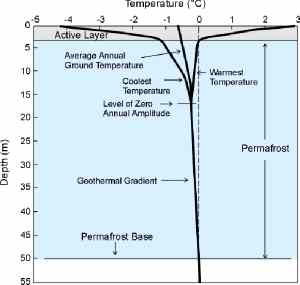 Mean annual near-surface ground temperatures below 0 oC lead to permafrost formation and continued growth. The rate of growth of the permafrost layer thickness is a complex function of air temperature modified by the insulation of snow. The combination of factors working on various time and space scales that lead to permafrost formation and growth make its response to climate change very complicated. Even in areas where the mean annual air temperature is below freezing, permafrost may not always be found, for land under glaciers, rivers, and streams can often be free of permafrost despite below freezing air temperatures at the surface. Mean annual near-surface ground temperatures below 0 oC lead to permafrost formation and continued growth. The rate of growth of the permafrost layer thickness is a complex function of air temperature modified by the insulation of snow. The combination of factors working on various time and space scales that lead to permafrost formation and growth make its response to climate change very complicated. Even in areas where the mean annual air temperature is below freezing, permafrost may not always be found, for land under glaciers, rivers, and streams can often be free of permafrost despite below freezing air temperatures at the surface.
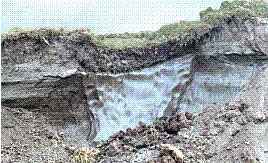 |
|
| A cross-section of permafrost shows an ice wedge hiding just below the surface. |
Permafrost may extend only in a layer just below the surface from tens to hundreds of centimetres (inches to yards) in depth or it may reach great depths. Thin permafrost layers usually form over decades, but a layer only thickens to over 30 m (100 ft) over millennia. In Siberia the permafrost layer is as much as 1500 metres (5,000 feet) thick. In northern Alaska, maximum thicknesses are around 600 m (2,000 ft). In Canada's North, a borehole drilled on Melville Island, showed that the ground was frozen to a depth of at least 450 m (1,475 ft), and permafrost may be well over 300 m (1000 ft) thick in the more westerly, unglaciated portions of the Yukon Coastal Plain.
Therefore, although permafrost can be thousands of years old, it may also be newly formed or about to melt away completely, and it often exists close to its melting point for many years before either disappearing completely or descending further below the surface.
 Variations in surface environmental conditions influence the character of the permafrost layer below, and permafrost changes may not be due solely the result of weather or climate swings. Alterations in the thermal character of the surface, such as those caused by forest fires in the boreal forests overlying much of Northern Hemisphere permafrost, often affect the ground heat conditions more rapidly than do fluctuations in climate. For example, recent permafrost degradation in the Takhini Valley near Whitehorse in Canada's Yukon Territory has been, in part, attributed to forest fires. However, climate warming over decades, particularly if they involve changes in snow accumulation as well, may significantly deplete a permafrost layer. Observations in the permafrost today indicate significant changes are in progress as a result of the very warm conditions in the Arctic region over the past decades. Variations in surface environmental conditions influence the character of the permafrost layer below, and permafrost changes may not be due solely the result of weather or climate swings. Alterations in the thermal character of the surface, such as those caused by forest fires in the boreal forests overlying much of Northern Hemisphere permafrost, often affect the ground heat conditions more rapidly than do fluctuations in climate. For example, recent permafrost degradation in the Takhini Valley near Whitehorse in Canada's Yukon Territory has been, in part, attributed to forest fires. However, climate warming over decades, particularly if they involve changes in snow accumulation as well, may significantly deplete a permafrost layer. Observations in the permafrost today indicate significant changes are in progress as a result of the very warm conditions in the Arctic region over the past decades.
Permafrost Life
 A common misconception is that the Arctic permafrost zone is a barren wasteland, but it is actually home to a wide variety of birds, mammals and insects and a surprising diversity of plants. And, although many of us probably imagine the permafrost regions as the tundra and ice lands of the far North, populated by polar bears and vast herds of caribou, much of the Northern Hemisphere permafrost is actually overlain by evergreen boreal forests. A common misconception is that the Arctic permafrost zone is a barren wasteland, but it is actually home to a wide variety of birds, mammals and insects and a surprising diversity of plants. And, although many of us probably imagine the permafrost regions as the tundra and ice lands of the far North, populated by polar bears and vast herds of caribou, much of the Northern Hemisphere permafrost is actually overlain by evergreen boreal forests.
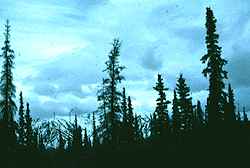 The trees and shrubs that grow in these boreal forest are much smaller than related species found to the south, and their tissues are far more resistant to freezing and thawing. Sparse black-spruce forests called taiga -- from the Russian for "land of little sticks" -- dot north-facing mountain slopes and poorly drained lowlands of the boreal forests. Stands of white spruce, aspen, and birch are typically found on warmer, south-facing slopes. Near the tree line, shrub-thicket communities of dwarf and resin birch, alder and willow dominate. Beneath the boreal forest trees, heath, moss and lichens make up the understory. The trees and shrubs that grow in these boreal forest are much smaller than related species found to the south, and their tissues are far more resistant to freezing and thawing. Sparse black-spruce forests called taiga -- from the Russian for "land of little sticks" -- dot north-facing mountain slopes and poorly drained lowlands of the boreal forests. Stands of white spruce, aspen, and birch are typically found on warmer, south-facing slopes. Near the tree line, shrub-thicket communities of dwarf and resin birch, alder and willow dominate. Beneath the boreal forest trees, heath, moss and lichens make up the understory.
The biologically active surface layer of permafrost is a thin slice of soil and vegetation that thaws every summer and freezes hard each winter. The permafrost beneath the thawed layer prevents or impedes drainage, forming wetlands in low-lying areas.
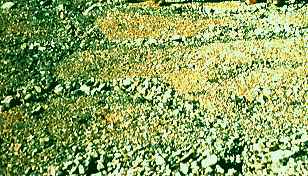 The open plains of permafrost north of the tree line make up the tundra biome. Here, arctic plants have evolved myriad specialized adaptations for life on the often frigid and usually windswept tundra. Arctic plants must have very short roots because of permafrost. Tundra vegetation consists mostly of sedges, mosses and lichens. The lichens play a particularly important role in the permafrost ecosystem, helping to break down the surface rocks into a thin soil where other plants and small animals can gain a hold. During the brief summer grasses and attractive flowering plants appear, some completing their entire life cycle within a month. The open plains of permafrost north of the tree line make up the tundra biome. Here, arctic plants have evolved myriad specialized adaptations for life on the often frigid and usually windswept tundra. Arctic plants must have very short roots because of permafrost. Tundra vegetation consists mostly of sedges, mosses and lichens. The lichens play a particularly important role in the permafrost ecosystem, helping to break down the surface rocks into a thin soil where other plants and small animals can gain a hold. During the brief summer grasses and attractive flowering plants appear, some completing their entire life cycle within a month.
On the open tundra, permafrost forms an impenetrable layer to water movement. In areas where a thin layer of soil thaws during summer, the permafrost's frozen sublayer keeps the water on the surface. This meltwater thus forms vast marshy areas and many shallow lakes and ponds that dot the landscape for a brief time.
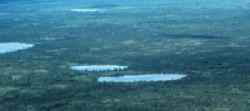
During the long, generally sunny summer days, the permafrost wetlands are alive with insects and birds. Insects and other invertebrates inhabit the regions in and around these wetlands. Generally, the adult insects winter below the snow, but the eggs and pupae of some can survive below the surface. The internal body fluids of some adult insects, acts as an antifreeze and enables them to withstand extreme cold without freezing.
 |
|
Sandpiper Painted by
Edward W. Nelson, 1882 |
The long summer days, the shallow waters, and the abundance of insects and grasses on which to feed make the permafrost wetlands ideal breeding grounds for many ground-nesting birds. From the first days of spring, when tundra grasses are tender green, millions of migratory birds stream northward to breed. Wetland ponds and local rivers ripple with the soft landings of waterfowl such as oldsquaw, eiders, snow geese and tundra swans throughout the brief summer. Some 130 species including waterfowl, sandpipers and plovers, and some hawks, ptarmigans, cranes, owls, larks, and finches inhabit this thawed land.
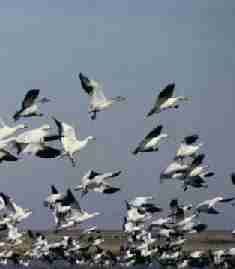 Besides the caribou and polar bears, permafrost areas (boreal forests and tundra) support other land mammals. Large land mammals include other bears and musk oxen. Among the smaller mammals, we find rodents such as voles and lemmings; weasels such as ermines, martins and sables; foxes; squirrels; and hares. Besides the caribou and polar bears, permafrost areas (boreal forests and tundra) support other land mammals. Large land mammals include other bears and musk oxen. Among the smaller mammals, we find rodents such as voles and lemmings; weasels such as ermines, martins and sables; foxes; squirrels; and hares.
Though the permafrost regions teem with life during the days of the midnight sun, the brief summer's heat soon wanes and in the last russet days of fall, entire flocks of geese weave lacy white patterns against a cobalt sky as they head for warmer climes in the south. And then, almost suddenly, the cold regains it vise grip and the land refreezes, falling silent save for the ever-constant moaning of the wind.
Learn More From These Relevant Books
Chosen by The Weather Doctor
- Williams, Jack: The Complete Idiot's Guide to the Arctic and Antarctic, 2003, Alpha Books, ISBN 1592570739.
- Alley, Richard B.: The Two-Mile Time Machine, Princeton University Press, 2000, paperback edition, ISBN 0691102961, (Hardcover Edition ISBN: 0691004935),.
Written by
Keith C. Heidorn, PhD, THE WEATHER DOCTOR,
February 1, 2001
The Weather Doctor's Weather Almanac Permafrost: Specter of The Great Ice Ages
©2001, Keith C. Heidorn, PhD. All Rights Reserved.
Correspondence may be sent via email to: see@islandnet.com.
For More Weather Doctor articles, go to our Site Map.

I have recently added many of my lifetime collection of photographs and art works to an on-line shop where you can purchase notecards, posters, and greeting cards, etc. of my best images.

Home |
Welcome |
What's New |
Site Map |
Glossary |
Weather Doctor Amazon Store |
Book Store |
Accolades |
Email Us
|



|









